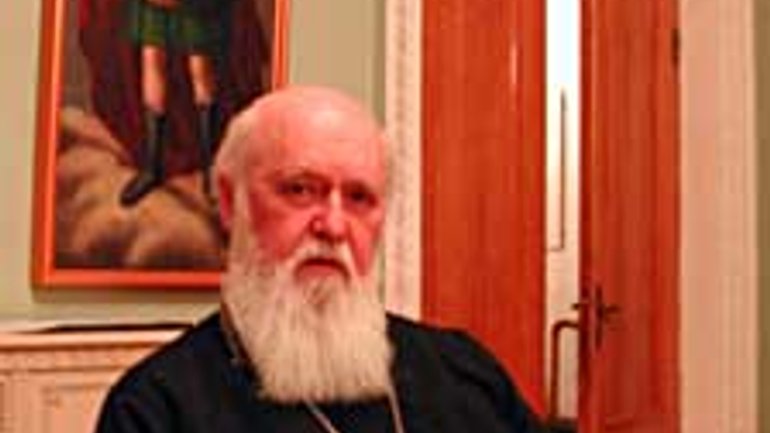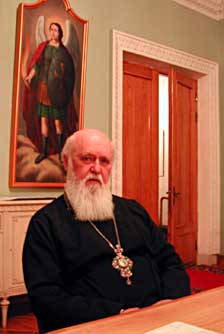Interview with Patriarch Filaret (Denysenko)

“One should not be arguing and fighting before this commonly recognized Christian relic”
Interview with Patriarch Filaret (Denysenko),
head of the Ukrainian Orthodox Church-Kyivan Patriarchate (UOC-KP)
 — What is your vision of today's state of the UOC-KP? Is the number of parishes and faithful of the UOC-KP increasing?
— What is your vision of today's state of the UOC-KP? Is the number of parishes and faithful of the UOC-KP increasing?
– Over the last few years, I mean the period from 1995 to 2003, the Ukrainian Orthodox Church-Kyivan Patriarchate has developed significantly. If in 1995, for instance, we had 19 eparchies, today we have 33. In the past, we had 18 hierarchs and now we have 37. The number of parishes increased from 2200 to 3600. Currently, the Kyivan Patriarchate has 10 million faithful, while the Moscow Patriarchate has only 5 million followers. Therefore, the Kyivan Patriarchate has twice as many supporters. These are the data provided by various sociological institutions.
— Is the number of parishes also increasing in southern Ukrainian regions?
– The expansion of the UOC-KP is taking place in eastern, southern, and partially, central and northern Ukrainian territories. In western regions, the distribution has already been completed. For example, in eastern Ukraine's Dnipropetrovsk region we have 200 parishes, while 8 years ago there were only 12 parishes. The UOC-KP's influence is not only about getting more parishes, but also about establishing new monasteries and educational institutions. Today, we have four higher educational institutions and six seminaries that train more than 1,500 students. We regularly publish a church newspaper, magazine and calendars. In addition, we publish books in Ukrainian. Recently, we published a bible in Ukrainian and are planning to distribute 150,000 free copies across the country. We have published all the major prayer and service books in Ukrainian, which has never been done before. All this work has been done over the last eight years.
The UOC-KP is becoming stronger. That is why representatives of the Moscow Patriarchate feel like foreigners in Ukrainian territories. I do not want to speak for the whole UOC-MP, but the clergy (priests and bishops) feel they will not be able to stay long within the Moscow Patriarchate in Ukraine. Sooner or later, they will have to unite with the Kyivan Patriarchate and create a single national Orthodox Church in Ukraine. Ukraine as a state and the Ukrainian people call for the creation of a single national Orthodox Church.
— How far have you gone in solving the issue of the unity of Orthodoxy in Ukraine?
– The negotiations between Moscow and Constantinople go on, but so far no positive results have been achieved. The UOC-KP and the Ukrainian Autocephalous Orthodox Church do not take part in these negotiations, which impacts their productiveness. Despite the fact that these negotiations have not led to any positive results, we believe that time will come when the Ukrainian church will be recognized as a national church by other national Orthodox churches, because the Ukrainian state exists and it is already strong. This state is home to the Ukrainian Orthodox Church-Kyivan Patriarchate, which is expanding and becoming stronger. This gives us hope that some time in the future world Orthodoxy will recognize the Ukrainian Church. We are sure of it.
— Today, the Minsk copy of the Shroud of Turin is displayed for veneration in Odesa. Representatives of the UOC-MP said it “is not a relic for Orthodox believers” and “has nothing in common with the original.” How can you comment on these statements?
– We all know that this is a copy of the Shroud of Turin. The original is preserved in the Italian city of Turin and owned by the Roman Catholic Church. This is a commonly recognized Christian relic, and not only the property of the Roman Catholic Church. That is why we treat the copy of the Shroud of Turin as a relic, because the shrouds that we lay out for veneration on Good Friday are not originals. Here we have an image of Christ from the authentic shroud. Venerating the copy, we give respect to and bow before the passion of our Lord, Jesus Christ. This relic strengthens faith among Christians. The clergy of the Moscow Patriarchate speak against the copy of the Shroud of Turin in vain, since they have never seen this shroud and have an extremely vague image of what the shroud of Jesus Christ is. The clergy of the Moscow Patriarchate should not give the commonly recognized Christian relic such condescending treatment.
— Metropolitan Ahafanhel of Odesa of the UOC-MP and the pro-Russian organization “Single Fatherland” in Odesa stated that Orthodox believers should venerate the shroud whose copy is currently in Russia. Metropolitan Ahafanhel did not give his blessing for the veneration of the copy of the Shroud of Turin.
– If the copy of the shroud Metropolitan Ahafanhel mentions was made from the Turin copy, then they are of equal value. One should not be arguing and fighting before this commonly recognized Christian relic. On the contrary, venerating this relic either in Odesa, in Kyiv, in Moscow or in Turin, we bow before our only savior, Jesus Christ and his shroud. There are no different kinds of shrouds, Russian or European, Orthodox or Catholic. There is a common Christian relic. The only one. And copies may be numerous. I repeat, one should not incite feuds among Christians near this relic.
Interview conducted in Odessa and Kyiv on 16 November 2003 by Ihor STOLIAROV









